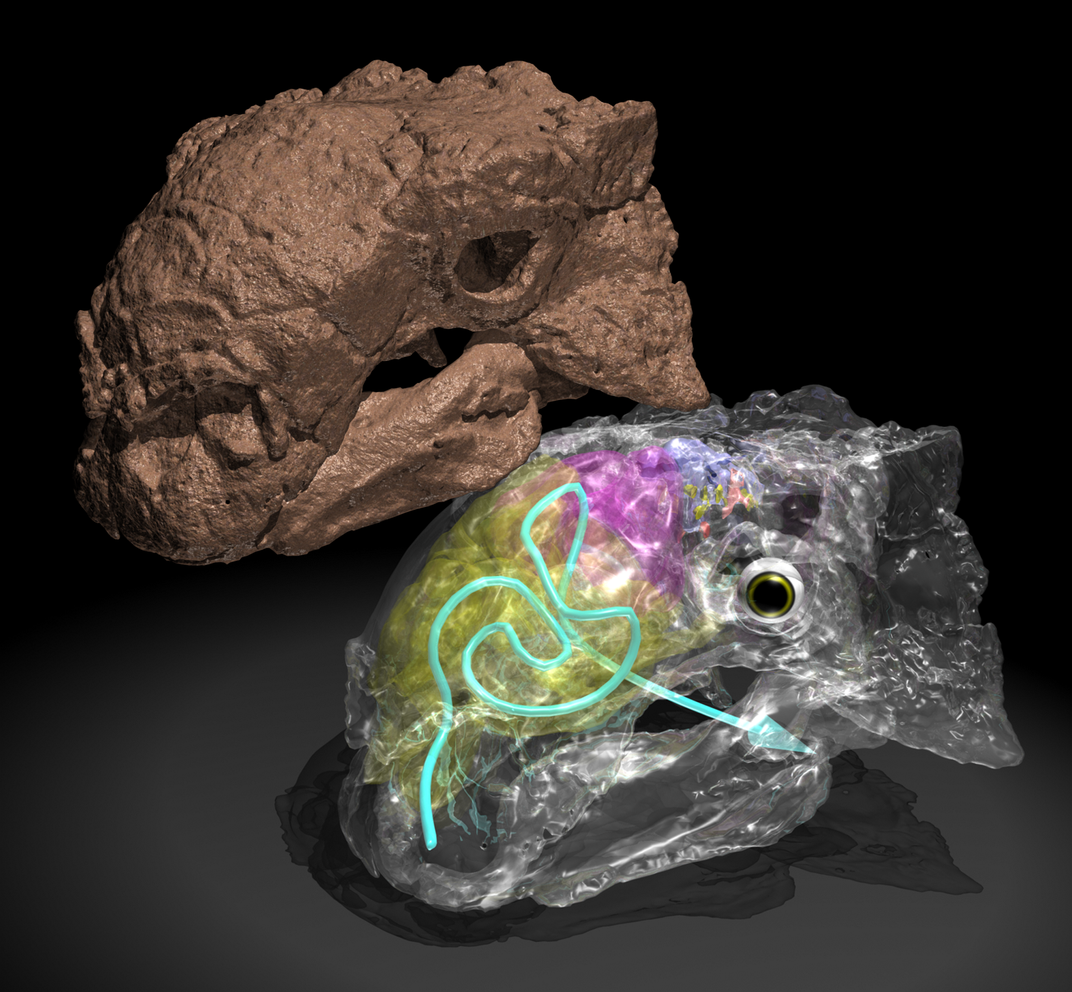Armored Dinosaurs Kept Cool With a Labyrinth of Nasal Canals
A fluid dynamics study suggests the large and intricate passages in ankylosaurs’ skulls were a great way to cool off in the Cretaceous
:focal(2263x864:2264x865)/https://tf-cmsv2-smithsonianmag-media.s3.amazonaws.com/filer/42/61/4261703c-bbd6-4252-83e2-f32537c07fb8/f02e5g.jpg)
Ankylosaurs are famous for their ornate outgrowths of bony armor. Spikes, tail clubs and even pebbly bits of armor over their eyes decorated their bodies, so much so that these dinosaurs have often been called “living tanks.” But there’s another unusual ankylosaur feature that has attracted the curiosity of paleontologists. Ankylosaurus and its relatives had winding, maze-like nasal passages, and according to a new study, these biological vents might have helped keep the bulky dinosaurs cool in the heat of the Cretaceous.
Paleontologists have been wondering about the complex noses of ankylosaurs since at least the 1970s. Why these trundling, spiky dinosaurs would have meandering nasal passages taking up so much space in their skulls is something of a mystery. Various explanations have been proposed—perhaps the air spaces housed some kind of gland, aided the dinosaurs’ ability to smell, acted as a resonating chamber, or somehow assisted respiration—but none of these hypotheses fully explained the armored dinosaurs’ strange noses.
It seemed impossible to tell just by looking at the labyrinthine of passages. But in a new PLOS ONE study that modeled the airflow within the noses of the ankylosaur species Panoplosaurus mirus and Euoplocephalus tutus, Ohio University anatomist Jason Bourke and colleagues were able to investigate how ankylosaur noses helped these dinosaurs dump excess heat.
“Prior to our work,” Bourke says, “the thought that these crazy-straw noses were aiding in thermoregulation was based solely on a basic understanding of physics and comparisons with modern animals.” No one had tested the idea thoroughly, so Bourke and colleagues set about simulating how air would have circulated through the noses of ankylosaurs, drawing from a previous study examining the noses of the dome-headed pachycephalosaurs.

Breathing life into dinosaurs that have been dead for over 66 million years was no small task. “This is a common problem in paleophysiology,” Bourke says. “All the things we are interested in don’t fossilize.” To get around that roadblock, Bourke studied what’s known about how birds, crocodylians and lizards breath. His team accounted for details such as the estimated temperature and humidity of inhaled air, applying the habits of living animals to long-extinct dinosaurs.
“I’m really excited about the fluid dynamics approach taken here,” says Victoria Arbour, a paleontologist with the Royal British Columbia Museum. “It’s not something we’ve seen often applied to dinosaurs, and it’s provided a really powerful insight into a particularly weird aspect of ankylosaur anatomy.”
Bourke and his team found that the twists and turns in ankylosaur noses make them efficient heat exchangers, allowing these dinosaurs to shed body heat. However, despite living in the same place at the same time, the nose of Euoplocephalus was better at cooling air than that of its neighbor Panoplosaurus. The nasal differences may have had to do with the larger size of Euoplocephalus—bigger bodies cool down and warm up slower than smaller ones, so a better air conditioning system in the larger dinosaur might be expected—but Bourke also suspects that different life habits may have played a role. For example, Euoplocephalus may have lived in open habitats with more exposure to the sun, or maybe Euoplocephalus subsisted on less-nutritious vegetation that fermented in its gut, increasing its body heat.
Nevertheless, both dinosaurs faced the same problem. Large herbivorous dinosaurs lived in warm climates and were warm-blooded. “Being able to keep the brain at a steady temperature would have been crucial for survival,” Arbour says. And this doesn’t just apply to ankylosaurs. Bourke notes that “crazy nose elaboration” has been seen in duck-billed dinosaurs such as Parasaurolophus and sauropod dinosaurs like Giraffatitan. “It’s possible that the nose was an important factor in letting so many dinosaurs cross into multi-tonne territory,” Bourke says.
By analyzing ancient bones with cutting-edge technology, the unique nature of dinosaurs only becomes more apparent. “The big deal is that we’ve shown that large dinosaurs had a way to cool or warm air that was different from the way mammals and modern birds do,” Bourke says. Instead of thin, rolled structures made of bone or cartilage—called turbinates—non-avian dinosaurs evolved their own way of accomplishing the same physiological task. Elaborate nasal passages are part of the dinosaur success story, allowing the “terrible lizards” to gain sizes that would have been impossible without their own method of air conditioning.
The new research helps define the role of these dinosaurs’ noses, but it doesn’t rule out other functions for ankylosaur nostrils. While ankylosaur nasal passages helped the dinosaurs keep cool, “it’s also entirely possible that the different shapes of the nasal passages could have produced different sounds, similar to what’s been proposed for the crested duck-billed dinosaurs like Lambeosaurus and Parasaurolophus,” Arbour says.
Not only did maze-like nasal passages help these dinosaurs keep cool and perhaps indicate something about their lifestyle, but the same structures could have served as a veritable Cretacean brass section. While our fascination with dinosaurs often focuses on their teeth, claws, armor and other flashy features, it seems that one of the best ways to get to know them is by taking a look up the nose.
/https://tf-cmsv2-smithsonianmag-media.s3.amazonaws.com/accounts/headshot/RileyBlack.png)


/https://tf-cmsv2-smithsonianmag-media.s3.amazonaws.com/accounts/headshot/RileyBlack.png)